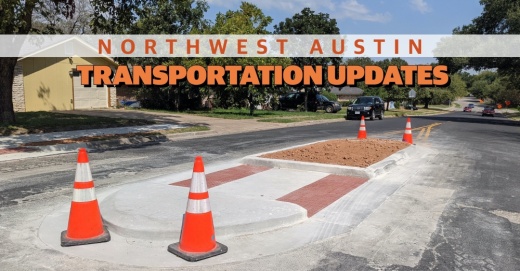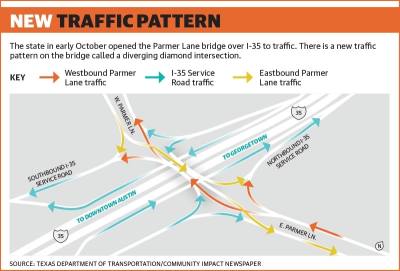After over two years of construction, the Texas Department of Transportation opened the intersection at I-35 and Parmer Lane as a diverging diamond in early October.
With the new design, drivers turning left and through traffic are able to go through the intersection simultaneously. To do so, traffic will temporarily shift to the left side of the road where Parmer goes over I-35. TxDOT’s I-35 at Williams Drive project is in the process of building a similar intersection design.
“After the Parmer Lane bridge is reconfigured into a [diverging diamond intersection], crews will construct the median island across the bridge, reconstruct the North Lamar Boulevard at Parmer Lane intersection, and finalize various improvements throughout the corridor, including bicycle and pedestrian accommodations, drainage, wastewater and high-mast illumination,” said TxDOT public information officer Brad Wheelis in an email.
With the Parmer bridge now open, state officials said the remainder of work at I-35 at Parmer is on track to be complete in early 2022.
The project began in July 2019 and cost $24.6 million with funding coming from Texas Clear Lanes and the Capital Area Metropolitan Planning Organization.
Read more about this project here.
Capital Metro moves forward with $255 million investment in electric buses
Local transit agency Capital Metro took another step toward its goal of transitioning to zero emissions by approving the purchase of 197 electric powered buses during its Sept. 27 meeting.
The board of directors unanimously approved the $255 million purchase from two manufacturers: Proterra and New Flyer.
According to a Capital Metro press release, the purchase represents the largest procurement of electric vehicles in U.S. history. The transit agency has a total of 424 buses currently, with 12 of those being electric.
The buses will roll out over the course of the next five years, according to Capital Metro documents. They will have vinyl seats with USB ports, a perimeter seating format and validators to check tickets at all doors.
Capital Metro Chief Operating Officer Dottie Watkins said the electric vehicles present numerous advantages including the reduction of greenhouse gases and air pollution.
“Recently, I was helping staff at one of our Q2 Stadium events and walking down the line of buses, and immediately noticed when I was walking past the electric buses it was both cooler and quieter,” Watkins added. “It's a much better environment, not just for our riding public, but for our community as a whole.”
Of the 197 buses, 178 will be 40-feet long and will be able to travel an average of 114 miles per charge; and 19 will be 60-feet long and will be able to travel an average of 95 miles per charge. Watkins said charging the vehicles will likely include a mix of on-route charging and charging at the bus depot, but Capital Metro is continuing to evaluate its long-term strategy.
Capital Metro announced its plan to shift to zero-emission vehicles on Earth Day in 2019. The following year it constructed a charging facility and began to use 12 electric buses, which rotate throughout various routes.
Read more here.
ONGOING PROJECTS
Safe Routes to School improvementsCity of Austin crews in late September started work on pedestrian improvements around Wooldridge Elementary School. Construction began along Hunters Terrace. Read more here.
Timeline: September 2021-late 2022
RM 2222 to RM 620 bypass
The southbound bypass lane connecting RM 2222 to RM 620 is expected to fully open by December at the latest, according to state officials. Read more here.
Timeline: December 2019-late 2021








